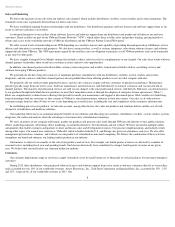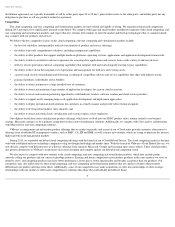VMware 2013 Annual Report Download - page 20
Download and view the complete annual report
Please find page 20 of the 2013 VMware annual report below. You can navigate through the pages in the report by either clicking on the pages listed below, or by using the keyword search tool below to find specific information within the annual report.
Table of Contents
These are generally larger size transactions, typically driven by our direct sales force and are primarily attractive to our larger enterprise customers.
Transactional sales, in contrast, tend to be smaller in scope, shorter in duration with a standard one-year maintenance term, and are principally driven by
our sales channel partners. Historically, they have represented two-thirds to three-quarters of our overall sales.
During 2013, we expanded the sales of product suites, such as our vCloud suite, that integrate advanced management and automation features with our
vSphere cloud infrastructure platform and which are primarily sold through ELAs. We believe that ELAs help us grow our business by building long-term
relationships with our enterprise customers.
Although our year-over-year growth rates for overall sales and ELA sales both increased in 2013 compared to 2012, the year-over-year growth rate for
our transactional sales declined in 2013 compared to 2012. As we develop and add new product and service capabilities to our higher-end product offerings,
and as our ELA volume continues to grow, we may not be successful in our strategy to increase the value of the products and services sold through the
transactional business. Consequently, we may not be able to increase sales volumes in our transactional business or help attract new customers to our product
ecosystem with our enhanced product features and capabilities.
If our overall go-to-
market strategy is not successful, our growth rates may decline further, and our business, financial condition and results of operations
could be materially adversely affected.
Our sales cycles can be long and unpredictable, our sales efforts require considerable time and expense, and timing of sales is subject to changing
purchasing behaviors of our customers. As a result, our sales are difficult to predict and may vary substantially from quarter to quarter, which may cause
our operating results to fluctuate significantly.
The timing of our revenues is difficult to predict. Our sales efforts involve educating our customers about the use and benefit of our products and
services, including their technical capabilities, potential cost savings to an organization and advantages compared to lower-cost products and services offered
by our competitors. Customers typically undertake a significant evaluation process that has in the past resulted in a lengthy sales cycle which typically lasts
several months, and may last a year or longer. We spend substantial time, effort and money on our sales efforts without any assurance that our efforts will
produce any sales. In addition, product and service purchases are frequently subject to budget constraints, economic conditions, multiple approvals, and
unplanned administrative, processing and other delays. Moreover, the greater number of competitive alternatives, as well as announcements by our
competitors that they intend to introduce competitive alternatives at some point in the future, can lengthen customer procurement cycles, cause us to spend
additional time and resources to educate end users on the advantages of our product and service offerings and delay product and service sales. Economic
downturns and uncertainty can also cause customers to add layers to their internal purchase approval processes, adding further time to a sales cycle.
Additionally, as we sell more products and services to domestic and foreign governments, we may encounter lengthier sales cycles, complicated budgeting
processes and complex procurement regulations. These factors can have a particular impact on the timing and length of our ELA sales cycles and our overall
sales during any particular fiscal period may have greater variability as a greater portion of our sales is made utilizing ELAs.
Additionally, our quarterly sales have historically reflected an uneven pattern in which a disproportionate percentage of a quarter’s total sales occur in
the last month, weeks and days of each quarter. Similarly, our yearly sales have historically reflected a disproportionate percentage of the year’s sales in the
fourth fiscal quarter. These patterns make prediction of revenues, earnings and working capital for each financial period especially difficult and uncertain and
increase the risk of unanticipated variations in financial condition and results of operations. We believe this uneven sales pattern is a result of many factors
including the following:
If sales expected from specific customers for a particular quarter are not realized in that quarter or at all, our results could fall short of public expectations
and our business, financial condition and results of operations could be materially adversely affected.
We are dependent on our management and our key development personnel, and the loss of key personnel may prevent us from implementing our
business plan in a timely manner.
Our success depends largely upon the continued services of our existing management. We are also substantially dependent on the continued service of
our key development personnel for product and service innovation and timely development and
18
•
the tendency of customers to wait until late in a quarter to commit to a purchase in the hope of obtaining more favorable pricing;
•
the fourth quarter influence of customers spending their remaining capital budget authorization prior to new budget constraints in the following year;
and
•
seasonal influences, such as holiday or vacation periods.
























